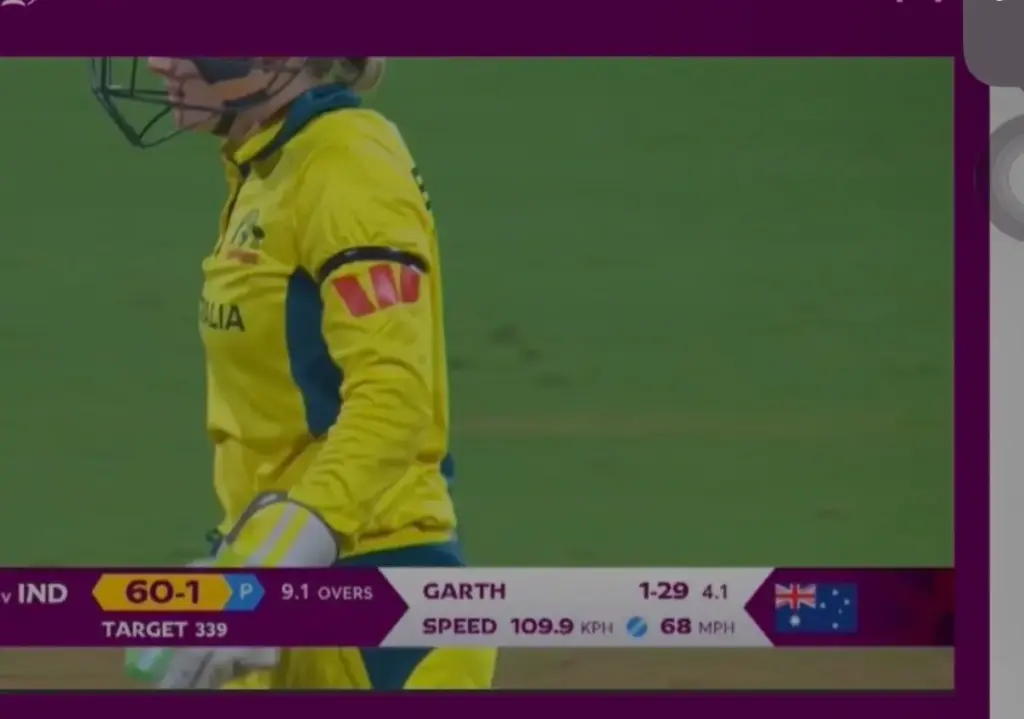Social media went into a frenzy after a viral post claimed that Smriti Mandhana was dismissed by a 159.6 kmph delivery during the India vs Australia Women’s World Cup 2025 semifinal at DY Patil Stadium, Navi Mumbai. The number, which would shatter every record in cricket history, quickly sparked debate among fans and experts alike.
But what’s the truth behind this unbelievable claim? Let’s break it down step by step.
| Aspect | Actual Fact |
|---|---|
| Bowler | Kim Garth (Australia) |
| Delivery Speed | Around 115 kmph |
| Viral Claim | 159.6 kmph |
| Source of Claim | Edited social media video |
| Official Confirmation | ICC match data shows no delivery above 121 kmph |
| Reality | DRS caught faint edge; Mandhana dismissed; fake speed graphic went viral |
Truth:
Smriti Mandhana was not dismissed by a 159.6 kmph delivery — but by a faint DRS edge that sparked one of the most viral cricket moments of 2025.
The Viral Moment: What Actually Happened
During India’s chase of 339 runs, Mandhana was batting confidently on 24 when Australian bowler Kim Garth delivered a ball down the leg side in the 10th over. The on-field umpire signaled it as a wide, but Australian captain Alyssa Healy opted for a DRS review after brief consultation.
The UltraEdge replay showed a faint spike as the ball passed close to Mandhana’s bat — leading to her dismissal. Shocked by the overturn, Mandhana was seen shaking her head in disbelief while walking back to the pavilion.
The moment, captured on cameras, quickly became viral — but things took a dramatic turn when an edited version of the clip surfaced online showing a speed reading of “159.6 kmph” on the broadcast graphic.
🚨The ball that dismissed Smriti Mandhana was clocked at 159.6 kmph — absolutely unplayable delivery 🔥#INDvAUS pic.twitter.com/SB3q6osKQM
— ICC Asia Cricket (@ICCAsiaCricket) October 30, 2025
Fact Check: No, The Ball Wasn’t 159.6 kmph
According to all verified match data and live broadcast records, Kim Garth’s delivery was clocked at around 115 kmph, which is well within the standard pace range for women’s international cricket.
Here’s the reality check:
| Claim | Fact |
|---|---|
| The ball was bowled at 159.6 kmph | False. The fastest ball ever recorded in women’s cricket is around 132 kmph. |
| Kim Garth clocked world-record pace | Incorrect. Garth is a medium-pacer, typically bowling between 110–120 kmph. |
| The broadcast showed 159.6 kmph | The viral video was digitally edited and not from the official ICC or broadcaster feed. |
The misleading graphic was likely a fan-made edit or an AI-generated overlay that circulated widely on platforms like X (Twitter), Instagram Reels, and YouTube Shorts.
Read Also:- Fastest Female Bowlers in the World
Why the Clip Went Viral
The combination of Mandhana’s stunned expression, the controversial DRS decision, and the wild speed number made the moment internet gold.
Fans, in disbelief, started resharing the video claiming the “fastest ball in women’s cricket” — despite it being scientifically impossible.
Within hours, the phrase “159.6 kmph ball” began trending on social media under hashtags like #SmritiMandhana, #INDvAUS, and #CWC25.
Even cricket forums and meme pages joined the frenzy, adding dramatic captions such as:
“Fireball from Kim Garth — Unplayable delivery to dismiss Smriti Mandhana!”
However, soon after, several fact-checking accounts clarified that no such speed was recorded in the ICC’s official match feed.

What’s a Normal Bowling Speed in Women’s Cricket?
To understand how exaggerated the 159.6 kmph claim is, here’s a look at the typical bowling speeds in women’s international cricket:
| Category | Bowler | Average Speed (kmph) |
|---|---|---|
| Fastest Recorded (Women) | Shabnim Ismail (SA) | 132 kmph |
| Top Indian Pacers | Renuka Thakur, Pooja Vastrakar | 115–120 kmph |
| Kim Garth (Australia) | Medium Pace | 110–118 kmph |
| Claimed Speed in Viral Video | – | 159.6 kmph (Fake) |
A 159.6 kmph delivery would exceed even Shoaib Akhtar’s 161.3 kmph record — the fastest in cricket history — which clearly proves how impossible the claim is.
Understanding the Real Incident
The actual controversy wasn’t about speed — it was about the DRS decision.
- The ball was declared wide initially.
- Australia reviewed.
- UltraEdge showed a faint spike, leading to Mandhana’s dismissal.
- Mandhana walked off visibly frustrated, shaking her head.
This moment, combined with her shocked reaction, made it look like something extraordinary had happened — fueling the viral misinterpretation online.
Expert Views on the Incident
Cricket analysts and commentators present at the game dismissed the speed claim immediately.
- Aakash Chopra noted: “The DRS call was marginal, but the speed number circulating online is fake. There’s no way any women’s bowler clocks 159 kmph.”
- Mel Jones, commentating for the ICC broadcast, added: “That was around 115 kmph, not 159.6! Let’s not get carried away by social media edits.”
Even the ICC’s official match data later confirmed that no ball in the semifinal exceeded 121 kmph.
Final Verdict
The claim that Smriti Mandhana was dismissed by a 159.6 kmph delivery is completely false.
It originated from an edited social media clip and spread rapidly due to Mandhana’s visible disbelief during her dismissal and the dramatic nature of the semi-final.
In reality:
- The ball was a 115 kmph leg-side delivery.
- The dismissal resulted from a DRS review showing a faint edge.
- The “159.6 kmph” figure was fake and digitally added.
Conclusion
The viral “159.6 kmph ball” claim may have made headlines, but it’s another example of how misinformation spreads faster than fact. The real story from that semifinal remains far more inspiring — Jemimah Rodrigues’ unbeaten 127* and India’s historic World Cup final qualification.
Smriti Mandhana’s dismissal may have looked shocking, but the truth is simple:
It wasn’t lightning speed — it was just a moment of high drama in one of cricket’s most unforgettable matches.




